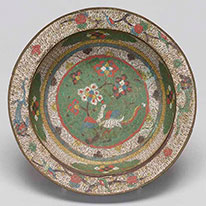Past Exhibitions
- Chinese and Japanese Cloisonné
- February 11, 2020 - February 26, 2020
Cloisonné (J: shippō or shippō yaki) is a decorative technique in which vitreous enamels, often edged with wire, are baked onto metal to form colorful glassy designs. In parts of the Middle East, Europe, and China, cloisonné production dates back over two millennia. Cloisonné was first made in Japan during the Asuka period (seventh century), influenced by imports from the continent. The tradition later died out in this country, though it continued in China. Then, beginning in the Ming dynasty (1368–1661), Chinese cloisonné objects again began pouring into Japan in great numbers, to be acquired by consumers with increasingly continental tastes. Over time, the Japanese began to copy these Chinese metalworks themselves, leading to a revival of domestic cloisonné production during the Edo period (1615–1868). This exhibition features a range of colorful cloisonné objects from both China and Japan.












